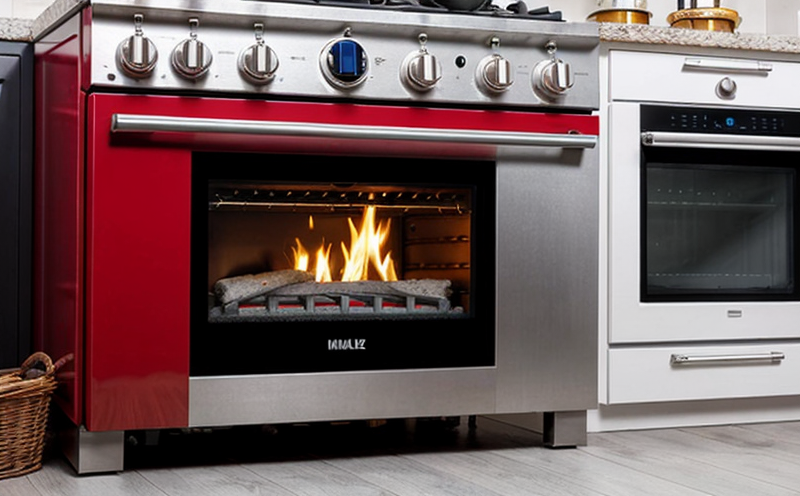Electrical and Thermal Aging Impact on Appliance Fire Performance
In the realm of fire safety testing, household appliances present a unique challenge due to their widespread use in domestic environments. The electrical and thermal aging process can significantly affect the fire performance of these products, leading to potential hazards if not adequately addressed during design and manufacturing stages. This service focuses on comprehensively evaluating how electrical and thermal aging impacts the fire behavior of household appliances.
Electrical aging refers to the gradual deterioration of insulation materials due to continuous exposure to electric fields. Over time, this can lead to a reduction in dielectric strength and an increase in leakage current, which may result in increased heat generation within the appliance. Thermal aging, on the other hand, involves the degradation of materials under elevated temperatures, affecting their mechanical properties and resistance to fire.
The impact of these aging processes can be profound. For instance, a refrigerator or a washing machine that has undergone significant electrical and thermal aging may exhibit compromised insulation layers or weakened structural components, increasing the risk of fire during normal operation or under fault conditions. This service aims to provide critical insights into how such aging affects the overall fire performance of appliances by simulating real-world scenarios in controlled laboratory environments.
During testing, we carefully select and prepare specimens that represent typical household appliances, ensuring they are representative of those found in actual use. The testing protocol involves subjecting these specimens to both electrical stress and thermal exposure for extended periods. This process closely mimics the conditions under which appliances operate over their lifetimes.
Our laboratory utilizes advanced instrumentation capable of accurately measuring key parameters such as heat release rate, smoke production, and flame spread. These measurements are crucial in assessing the fire performance of the specimen throughout the aging process. The data collected is then analyzed to determine any changes in the appliance's behavior compared to its initial state.
Understanding these changes is vital for ensuring that household appliances continue to meet stringent safety standards even after extended use. This service not only aids in meeting regulatory requirements but also helps manufacturers identify potential risks early in the product development cycle, allowing them to implement necessary improvements before products reach the market.
By leveraging this comprehensive testing approach, we provide valuable information that can inform design decisions and enhance product safety. This service is particularly beneficial for quality managers, compliance officers, R&D engineers, and procurement teams who are responsible for ensuring that their products meet rigorous fire safety standards throughout their lifecycle.
Applied Standards
To ensure the accuracy and reliability of our testing results, we adhere to a range of international and national standards. For electrical aging tests, we follow ISO/IEC 17864:2015, which specifies the procedures for determining the dielectric strength of solid insulating materials under varying conditions. This standard is crucial in assessing the insulation integrity of household appliances.
Regarding thermal aging, ASTM E398-18 provides guidance on testing the effects of heat on electrical and electronic products. This standard helps us evaluate how elevated temperatures affect the performance and safety of appliances over time. Additionally, EN 60335-2-42 is used to assess fire resistance properties after thermal aging.
Our testing also aligns with IEC 61897:2018 for assessing the flammability characteristics of household appliances under both electrical and thermal stress. This standard ensures that we cover a broad spectrum of potential risks associated with these products, providing comprehensive data to support informed decision-making.
Industry Applications
The results from this service are invaluable for various stakeholders within the industry. For quality managers and compliance officers, it provides a robust framework for ensuring that their products meet all relevant fire safety standards. This testing helps identify any potential shortcomings in design or manufacturing processes early on, preventing costly recalls and reputational damage.
R&D engineers benefit from this service by gaining deeper insights into the long-term effects of aging on appliance performance. Armed with this knowledge, they can innovate more resilient designs that maintain high safety standards even after prolonged use. This is particularly important in developing new products where understanding the aging process is critical for ensuring product longevity and user safety.
For procurement teams, these tests offer a means to evaluate supplier performance by comparing different suppliers' products based on their fire resistance under aging conditions. This ensures that only the highest quality components are used in final assemblies, enhancing overall product reliability.
Why Choose This Test
Choosing this service offers numerous advantages for those responsible for ensuring fire safety within household appliances. Firstly, it provides a clear and comprehensive understanding of the effects of aging on critical performance parameters such as heat release rate and flame spread. This knowledge is essential for maintaining compliance with relevant standards and regulations.
Secondly, this service enables early identification of potential design flaws or material weaknesses that could lead to fire hazards. By catching these issues at the development stage, manufacturers can make necessary adjustments before products reach the market, thereby reducing risks to end-users.
Additionally, it supports continuous improvement efforts by offering comparative data on different materials and designs. This allows for informed decision-making regarding which configurations best balance performance with safety. Ultimately, this service contributes significantly to enhancing product reliability and user confidence in the fire safety of household appliances.





